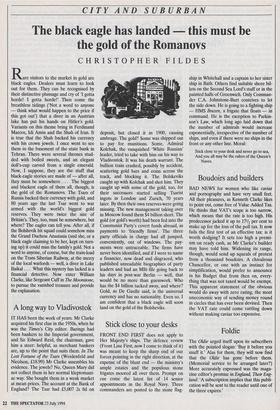A long way to Vladivostok
IT HAS been the work of years. Mr Clarke acquired his first clue in the 1950s, when he was the Times's City editor. Barings had been bankers to the Imperial government, and Sir Edward Reid, the chairman, gave him a steer: helpful, as merchant bankers are, up to the point that suits them. In The Lost Fortune of the Tsars (Weidenfeld and Nicolson, £18.99) Mr Clarke assembles his evidence. The jewels? No, Queen Mary did not collect them in her normal kleptomani- ac way. She bought them in a weak market at mean prices. The account at the Bank of England? The Tsar had £5,007 2s 8d on deposit, but closed it in 1900, causing umbrage. The gold? Some was shipped out to pay for munitions. Some, Admiral Kolchalc, the vanquished 'White Russian' leader, tried to take with him on his way to Vladivostok. It was his death warrant. The bullion train crashed, possibly by accident, scattering gold bars and coins across the track, and blocking it. The Bolskeviks caught up with Kolchak and shot him. They caught up with some of the gold, too, for their successors started selling Tsarist ingots in London and Zurich, 70 years later. By then their own reserves 'were going missing. The new management taking over in Moscow found them $4 billion short. The gold (or gold's worth) had been fed into the Communist Party's covert funds abroad, as payments to 'friendly firms'. The three party officials in charge had all jumped, conveniently, out of windows. The pay- ments were untraceable. The firms have never been identified, and if I were to name a financier, now dead and disgraced, who published unreadable biographies of party leaders and had an MI6 file going back to his days in post-war Berlin — well, that would be no more than guesswork. Who has the $4 billion tucked away, and where? Gold, as De Gaulle said, is the universal currency and has no nationality. Even so, I am confident that a black eagle will soon land on the gold of the Bolsheviks.


















































 Previous page
Previous page